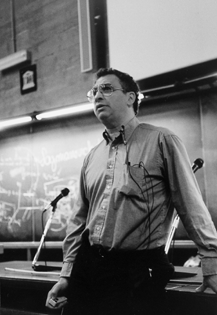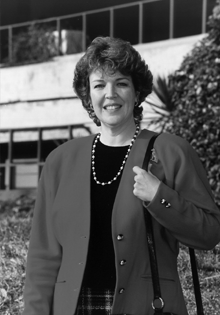Personal tools
News from ICTP 92 - Features - Mathematical Ecology

Mathematicians are exploring new ways to address critical issues related to ecology, genetics and population dynamics. It all adds up to a 'new math' that is stretching the traditional boundaries of the profession well beyond the classroom.
When Math Meets Ecology
Can we project the pathways of such deadly diseases as AIDS? Are we capable of anticipating future patterns of forest growth? What exactly is the relationship between biodiversity and healthy ecosystems?
These are some of the complex questions that mathematicians are
exploring as they turn from their chalk boards and note pads to
nature's fields, forests and rivers--putting their skills to work
in addressing critical problems of global concern.
The result is the emerging field of mathematical ecology and the
related field of ecological economics. The first seeks to address
ecological issues by applying such tools as mathematical models;
the second seeks to determine the value of so-called 'ecoproducts'
and 'ecoservices' often neglected by the market place--for example,
the value of an uncut tree in a national forest (can we place
a price on the aesthetic and recreational services the tree supplies?);
or an endangered species that escapes extinction (can we determine
the species' worth based on its contribution to the intricate
functioning of an ecosystem?).
The ICTP recently conducted a four-week course on mathematical
ecology that included a week-long introduction to ecological economics.
Presentations on risk and environmental assessment, population
dynamics, conservation biology and biological migrations revealed
the broad issues to which mathematical tools are being applied
to better explain the functioning and value of our natural world.

Simon Levin
As Princeton University's mathematical ecologist Simon Levin,
one of the course directors, explains: "Mathematical ecology
is a broad subject that ranges from highly theoretical and highly
abstract mathematical investigations to studies closely tied to
data."
"The best mathematical ecology," Levin asserts, "is
driven by biological questions, not mathematical ones. In a similar
vein, the best ecological economics is based on economic principles.
It seeks to account for goods and services that have often been
left out of market calculations despite their inherent contributions
to our ecological and economic well being."
Mathematical ecology emerged from the roots in the work of the
great Italian mathematician, Vito Volterra, who devised a series
of mathematical models on the increase in predator fish population-and
consequent decrease in prey fish population-in the Adriatic Sea
during World War I. Volterra's precedent-setting models were based
on research conducted by his son-in-law, Umberto D'Ancona, a distinguished
biologist at the University of Padua, who was interested in the
population dynamics among fish stocks in the Adriatic Sea.
Volterra used pen and paper and simple mathematical calculations
to draw his conclusions. Today high-powered computers and sophisticated
mathematical models drive the research efforts. A wide range of
studies has proven particularly fruitful in examining changes
in forests and fisheries, the spread of diseases and the loss
of biodiversity, particularly in tropical environments. More recently,
the effort has moved beyond specific resource areas into the theoretical
world of complex systems.
As Levin observes: "Ecological systems, like economic systems,
are complex adaptive environments where macroscopic patterns emerge
from microscopic interactions among individual agents on local
scales. Relating these scales," he maintains, "is a
fundamental challenge in the study of ecology."
Levin points to work on the impact of global climate on forest
ecosystems. "We can examine, with relative ease, the impact
that global climate change is having on the physiology of trees
within a forest. But the critical question is: how are changes
in the microenvironment affecting the dynamics of the entire ecosystem--the
soil, vegetation, insect populations and animal life within the
forest?"
The intricate relationships between the diverse components of
an ecosystem are not linear but interactive and dynamic. Understanding
these relationships requires high-speed computation and state-of-the-art
analytical strategies that allow researchers to simplify their
models without compromising the insights that these models provide
for what is happening in the real world.
For practitioners of mathematical ecology and ecological economics,
mathematics is a tool for grappling with larger ecological issues.
"The critical juncture in my career," explains Levin,
"occurred when I decided that to do good work in mathematical
ecology, I had to think like an ecologist rather than a mathematician.
What accounts for changes in the virulence of viruses? How much
vaccination is needed for control? What are the consequences of
social interactions or antibiotic resistance?"
"I now urge my students and postdocs who come from physics
or mathematics to do the same, instead of continuing to do research
that will impress their physics or math colleagues. Once they
choose to take this new path, they often do work that is more
impressive to their physics and math colleagues than if they had
continued to pursue more conventional research agendas."
However interdisciplinary relationships evolve among academic
colleagues, Levin is convinced that both "mathematical ecology
and ecological economics will grow in influence in the years ahead
as policy makers and the public seek quantitative solutions to
problems related to ecological and organisational complexity."
Ultimately, Levin says, we need to know how human activities,
as well as natural trends, are affecting goods and services that
ecological systems provide us-our very life support systems.
************
World of Opportunity

Graciela Ana Canziani
When Graciela Ana Canziani arrived at the Second Autumn Course on Mathematical Ecology in 1986, she had a problem. As an associate at the University of Buenos Aires and Argentina's Institute of Mathematics, she had refined her skills in mathematics--both as a teacher and researcher--and vastly increased her knowledge concerning the intricate and elegant world of matrices, equations and numerical algorithms.
But when a colleague in the architecture and urban planning department
asked her to use her skills to analyse the impact that continued
population growth would have on urban infrastructure--transportation,
water, sewage and school systems-she didn't have a clue about
how to examine such commonplace, yet critical, issues.
"I came to the Centre that first year seeking to find out
if and how I could use my knowledge in mathematics to address
these practical concerns," explains Canziani. "I left
the course not only with some answers on how to proceed but with
the prospects of a new world of opportunity in my chosen profession."
The new career pathways opened to Canziani were largely the result
of the ideas and inspiration of Thomas Hallam and Louis Gross,
both from the University of Tennessee in the United States. "Not
only have they been instrumental in the success of the Centre's
mathematical ecology activities from the beginning, but they have
had a lasting impact on the overall growth of the field in both
the developed and developing worlds."
Since her first visit to the ICTP, Canziani has transformed her
career from a traditional mathematician into a mathematical ecologist
by using her skills and knowledge in mathematics to address ecological
and economic issues that once seemed entirely disconnected from
her discipline.
Her involvement with the Centre reflects the growth of her career
over the past 15 years. In 1990 and 1992, she returned to the
Centre as a lecturer and, in 1996, she was appointed a course
director--an assignment she has assumed again this year for the
Fifth Course on Mathematical Ecology.
In addition to her participation in ICTP activities, Canziani
has launched a successful series of mathematical ecology courses
in the math department of her university, Argentina's Universidad
Nacional del Centro de la Provincia de Buenos Aires, and spearheaded
the organisation of a Latin American network of mathematical ecologists,
which now includes some 50 researchers from 9 countries.
Today she serves as a principal investigator for a US$1-million,
3-year project, funded by the European Union, which is designed
to provide a wealth of information and projections on the fast-growing
region of Esteros del Iberia, in northeast Argentina. The project
involves 11 universities in 6 nations in Latin America and Europe.
"Rapid population growth, increased tourism and intensive
rice cultivation," Canziani says, "are having a dramatic
impact on the area's ecology and traditional community structures.
Most observers agree that these pressures will become even more
acute in the future."
"Our job is to use our skills in mathematics and modelling
to analyse a whole range of parameters, including scenarios for
land use, hydrology and pesticide contamination. We are trying
to create a comprehensive state-of-the-art geographic information
system using remote sensors, on-site monitoring, historic data
and field studies. It's a huge multidisciplinary undertaking that
requires sophisticated quantitative inputs and analyses that can
only be provided through the use of mathematical tools."